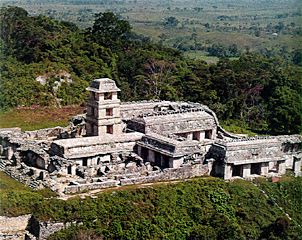

| The Palace. Photo by Merle Greene Robertson. |
By Merle Greene Robertson
From The Sculpture of Palenque, Vol II
(Revised)
|
On the western edge of the Maya realm, along the foothills of the Sierra de Palenque mountains, a small tribe of Indians in Preclassic times decided to make their home. The beauty of the natural surroundings, with their lush tropical vegetation and many streams and rivers cascading over low hills and across a small level area in the terrain, must have seemed quite appropriate to the small group that settled in what centuries later was to be known as Palenque.
It is not known with any certainty what these people called their community; quite possibly it was Lakam Ha', or "Big Water". (B'aakal, based on the word for "Bone", seems to have been the name of their kingdom.) Palenque still holds the mystical charm and appeal that must have been the deciding factor in that early group's choice of a home. Although the site dates back to Preclassic times, probably as early as 500 B.C., it did not achieve unusual importance until somewhere around the mid-7th century A.D. In Preclassic and early Classic times, until the Motiepa period (middle to late Early Classic), there is no evidence of substantial architecture. Thatched roofs over pole and thatched sides were all that was needed for housing in this tropical environment, and apparently the social structure at this time is not advanced to the point that would indicate the need for impressive buildings. According to the Palenque ceramic research of Robert L. Rands (1974:36), it may have been in Motiepa times that "the major ceremonial center shifted to its present location," that is to the area immediately surrounding the Palace structures. Earlier buildings were probably to the west, around the Oldivado (see map), and it was not until Otolum times (A.D. 600-700) that the major architecture of the site, as seen today, was erected. Rands (1976) believes that "Palenque might have existed on a chiefdom level at the time that states were already in existence in the Lowland Maya heartland but that, in the Otolum Complex, Palenque passed the threshold to statehood." |